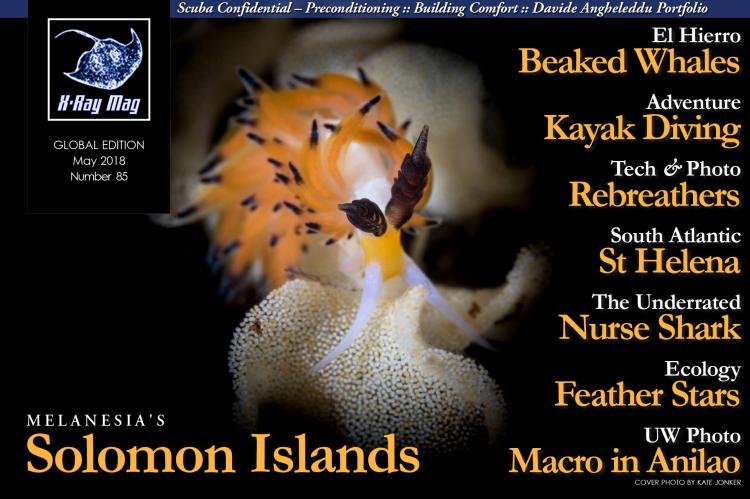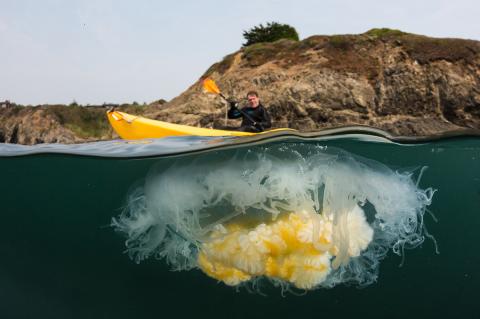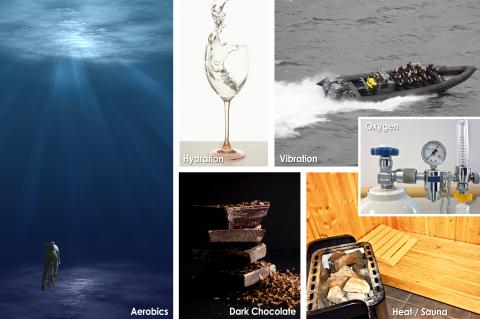X-Ray Mag #85
Main features in this issue include:
Analyzing the Obvious II: Retaining Divers by Building a Comfort Zone
In the first article in this series, we discussed the importance of building the diver’s comfort zone and how the comfort level of the newly trained diver affects his or her long-term participation in the sport. This begs the questions: how much impact does drop-out actually have on the sport; and what can the instructor do to correct the problem?
The impact of diver drop-out is very difficult thing to assess due to a lack of data. The findings discussed in the first article in this series only tracked divers who completed an open water diver course.
Beaked Whales of El Hierro
Beaked whales—now honestly, who has ever heard of Cuvier beaked whales (Ziphius cavirostris) or Blainville beaked whales (Mesoplodon densirostris), or even knows what they look like? Anybody? No? It’s no wonder—they are shy animals, they can be seen at the water surface only for a very short time and they are usually not very noticeable.
The whales also do not ride on the bow waves of boats, but rather avoid noise and are extremely quiet representatives of their kind—a species that lives quite inconspicuously in our world’s seas and hunts at great depths.
Developing the Mindset of a Successful Image Maker
Is underwater photography difficult? Actually, no—at least, not to any significant degree when compared with any other discipline of photography. Each single stage of creating an underwater photograph, if seen in isolation from the rest, is not so tricky. It is the sum of all its parts, as well as mastering the whole, which can appear confusing at times.
In terms of underwater photography, we can say that the mindset is the systematic approach to staying organized and getting the best out of our photo dives.
Fantastic Feather Stars and the Creatures Within
Crinoids, or "feather stars" as they are commonly known to the scuba diving community, are echinoderms, members of the phylum Echinodermata, meaning "spiny skin," which includes many well-known species like sea stars, sea urchins and brittle stars. Their highest concentrations are found around Indonesia, the Philippines, the Solomon Islands and Australia's Great Barrier Reef.
Many divers who have traveled to the Indo-Pacific are familiar with feather stars and admire them for their bright colors and interesting shapes. Feather stars are also well known to divers because of their propensity to attach to the wetsuits of careless divers.
Kayak Diving: Between the Boats & Beach
The words “dive trip” are enough to make most divers start daydreaming of warm water, great visibility, thin wetsuits and talented guides who can find critter after critter. Change those words to “dive adventure” and you will find a small group of divers who immediately think of kayak diving.
Scuba diving from a kayak is the perfect way to access reefs that are not otherwise accessible from land. The sites may be situated under steep cliffs or too far offshore for a surface swim.
Peer Pressure in the Dark Side
I was recently given this picture, signed by David Prowse—the original actor who played Darth Vader—by one of my students. It's awesome. Why? Well, I am a bit of a Star Wars fan and a lot of a geek anyway, but also, there is a little sub-culture in technical diving, especially cave and rebreather diving, in which divers like to refer to themselves as members of the dark side! It's kind of cool—well, for us anyway, and we like the T-shirts.
But let's look at this seriously for a minute. Why do these things appeal to us? Why do we like to be recognised and to have a group identity? Well, we could fall back on the “that-is-human-nature” argument, and certainly, there are cogent points to be made for this idea.
Davide Angheleddy Portfolio
Italian artist, designer and architect, Davide Angheleddu, creates bronze and nylon sculptures inspired by the forms of zooplankton, marine microorganisms. X-Ray Mag interviewed the artist to find out more about his artwork, creative process and perspectives on art, technology and the underwater world.
After graduating with a degree in architecture from the Politecnico di Milano, Angheleddu specialized in interior design at an architecture studio, where he amassed a great deal of knowledge and experience in 3D digital modeling.
Preconditioning for Safer Scuba Diving
This column is adapted from a chapter in my book, Scuba Physiological – Think you know all about Scuba Medicine? Think Again! The chapters in this book were originally written by scientists in the field of decompression research as part of a three-year project called PHYPODE (Physiology of Decompression). My (self-appointed) task was to rewrite their sometimes-complex research in a form accessible to all divers.
One interesting aspect they addressed was the concept of preconditioning as it may apply to scuba diving safety.
Rebreathers and Photography
There are many advantages to diving closed circuit for the underwater image creator such as better interaction with wildlife or longer dives. However, there are also a number of disadvantages to consider such as added complexity and task loading.
Why use rebreathers?
Smaller is Better in Anilao
My dive guide finned quickly down the sandy slope and I kicked hard to keep up with him, my heavy camera and strobes creating quite a drag, slowing me down. By the time I reached the sea fan, in front of which he had stopped, I felt a thrill of excitement. I knew what he had found! Peering through my viewfinder and trying to stay calm, I followed his pointer downwards, and right there, at its tip, was my first ever pygmy seahorse.
I had reached a stage in my underwater photography journey in which I wanted to do more than just take photos—I wanted to create works of art!
Solomon Islands – 75 Years after World War II
My journey to the Solomon Islands began with an exciting dive experience and an unforgettable taste of history. Passing 100ft (30m) on my way down to 170ft (52m), I began to question the intelligence of this decision. I was in a very remote corner of the globe, with minimal surface support, dropping to a very deep depth and all on a single tank of air.
The plan was simple, descend down the sloping coral reef until we hit the seabed, spend six to seven minutes on the bottom and then begin the slow ascent back to the surface, punctuated by 25 plus minutes of decompression stops.
St Helena: Reefs, Wrecks & Whale Sharks in the South Atlantic
The remote island of St Helena has been an enigma in the South Atlantic Ocean. Historically, the only way to visit the British territory was by Royal Mail ship or yacht. With limited yet lengthy sailings and even more limited and very expensive cabins, the island was effectively out of reach for most people.
Much has been made of the new airport on St Helena Island. And much has been made of the dramatic landings on St Helena. Our reality was simple: a three-hour-and-15-minute flight from our last refuelling stop over the azure Atlantic Ocean.
The Underrated Nurse Shark
Plentiful nurse sharks attended the sessions I held during my shark study in Tahiti. They are heavily-built animals with large, graceful fins, a long, pennant tail, and small eyes. They forage on the sea floor for a variety of foods at night and sleep in grottos in the coral during the days. Though these unusual sharks typically lie around on the sea floor, they are also capable of clambering.
Plentiful nurse sharks attended the sessions I held during my shark study in Tahiti. They are heavily built animals with large, graceful fins, a long, pennant tail, and small eyes. They forage on the sea floor for a variety of foods at night and sleep in grottos in the coral during the days.
Why, When and How to Use Rebreathers for Photography
There are many advantages to diving closed circuit for the underwater image creator such as better interaction with wildlife or longer dives. However, there are also a number of disadvantages to consider such as added complexity and task loading.
















